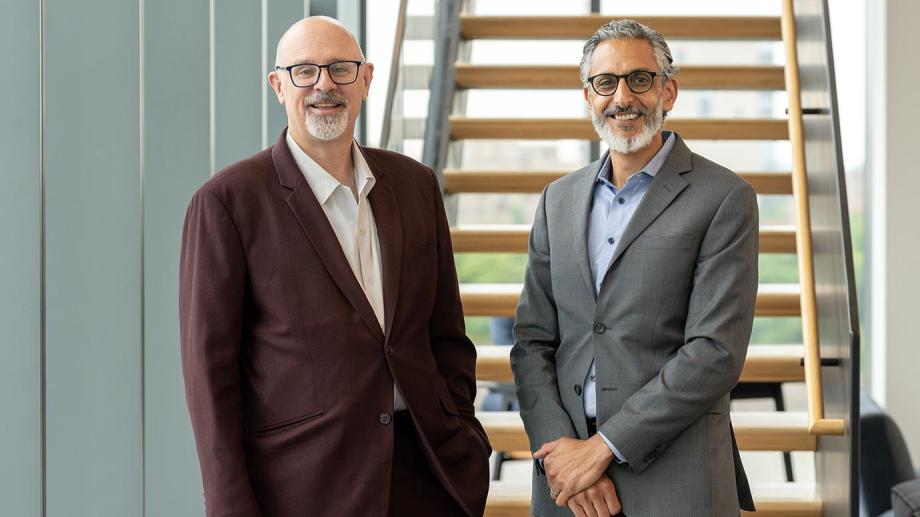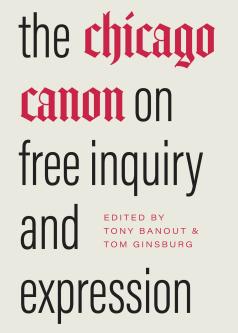Canonizing the Chicago Way: Free Inquiry and Expression
Tom Ginsburg and Tony Banout Discuss Their New Book, The Chicago Canon on Free Inquiry and Expression

In their meticulously curated new book, The Chicago Canon on Free Inquiry and Expression, Professor Tom Ginsburg and Tony Banout, executive director of the Chicago Forum for Free Inquiry and Expression, capture the pivotal texts and principles that have defined a tradition of open discourse and become a national model for other universities. The volume was a labor of love for both Banout and Ginsburg, the Leo Spitz Distinguished Service Professor of International Law, who also serves as the Chicago Forum’s founding faculty director.
“Tony’s been a great collaborator since we find that we have the same instincts in applying the principles in practice,” Ginsburg said. “Now our role is to bring forward the 130-year-old tradition to meet current challenges.”
What was your overall goal in publishing this work?
Tom: The genesis of this was actually some teaching materials [Dean] Tom Miles and I were working on, growing out of the Law School’s orientation sessions for students. For some years we have been giving incoming students the Kalven Report and the Stone Report of the Committee on Freedom of Expression and asking them to apply the texts to a concrete scenario. Tom and I had expanded these, leading us to look into the history of the University. The Canon integrates a number of the classic speeches and statements made by University leaders over the years.
Tony: I had been recently appointed to work with Tom to run the Chicago Forum for Free Inquiry and Expression and, while I knew a good deal about the University’s approach to free expression, working on the book was an ideal opportunity for a much deeper dive into the tradition.
How have the texts within the canon—from William Rainey Harper’s 1900 “Freedom of Speech” to the Kalven Report and the Chicago Principles—reflected changes in societal attitudes toward free inquiry and expression?
Tony: A major insight here is that Harper’s speech predates the emergence of First Amendment jurisprudence. So, while he uses the term “freedom of speech,” Harper signifies something distinct and more academic than what would emerge as the constitutional free speech framework.(Former Dean of the College] John Boyer’s history of the University was an indispensable guide in understanding the founding intentions Harper had, as were insights from Fred Buettler, a historian at the Graham School. Those historical trends and influences included the German research university and American pragmatism, then over a century later you have Geoffrey Stone and his colleagues on the Committee on Freedom of Expression integrating into this tradition language that parallels First Amendment doctrine. And in between you have the two waves of anti-communist hysteria and McCarthyism, the atomic bomb, and the Vietnam era. You’ll have to read the book for the full story!
Tom: One theme is that the sources of repression change over time, but our institution has withstood pressures to shift with the winds.
How can the University of Chicago’s model serve as a framework for addressing today’s free speech debates, both within academia and beyond?
Tom: For better or worse, our approach has received a good deal of attention during the last few years, as many universities have suffered free speech crises. Law schools, particularly our peer institutions, have not exactly been welcoming of all voices, and my view is that one reason for this is a tendency to make decisions in an ad hoc way, without grounding those decisions in policies. Having a framework is useful when a crisis arises, and that is true both within and outside the academy. The Kalven report idea that institutions should only speak on matters that have immediate impact on them is something that has potential application outside the academy, as Tony Casey and I have recently argued.
Tony: There is a key distinction between principles and practice. The articulation of principles is essential but never sufficient, and so much of our work at the Forum is about advancing practice. My hope is that the Chicago tradition described in the book is genuinely engaged and contested, wrestled with in good faith. Of course, I believe it provides the right basic structure, but the real work is figuring out how it applies now, given contemporary and quickly evolving challenges.
More than 100 institutions have adopted the Chicago Principles. In your view, what are the core reasons for their widespread influence?
Tom: The Principles resonate because they are very aligned with the First Amendment. In our case, as a private university, we aren’t required to use this framework, but it has worked for us, and I think the overall success of the University of Chicago in the realm of ideas shows that free-wheeling debate is compatible with a great university.
What was it like co-authoring this while working together at the Forum for Free Inquiry and Expression?
Tony: I’m quite fortunate that at the very start of my tenure, alongside our work to launch the Forum with a major convening and build the team and initiatives, I was able to work with Tom in this way as well.
Tom: It was great to bring Tony into the project and a lot of fun to bat around ideas together. We have a lot of work to do to build the Forum now, and we feel that the long tradition at this university both grounds us and gives us great responsibility to succeed.
How do you foresee higher education’s commitment to free expression evolving? Are there emerging challenges that you believe will necessitate a new chapter in this tradition?
Tom: Social media has changed the way people express themselves, and also posed challenges to teaching and research. Attention spans are a little shorter now. There is also a good deal of performative speech, in which people say things they may or may not believe. One general challenge is that the academy cannot really be an ivory tower when any conversation can be broadcast to the world. We have to establish norms and practices that give students to tools to speak out and learn from each other in conversation.
